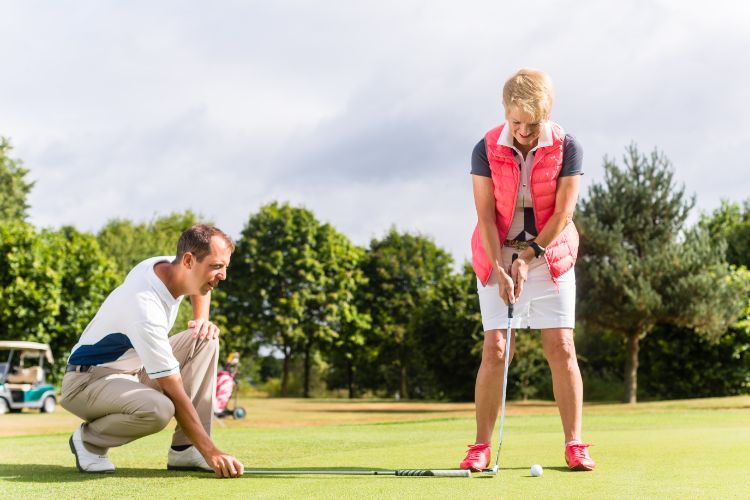Top Golf Drills To Improve Your Game
Posted by

Many beginners believe that improving their golf game is out of reach because of the complexity of the sport. Think of improving your golf game as putting together a puzzle.
At first, the pieces are scattered and there is no clear image. However, as you start to fit the pieces together, the image slowly takes shape.
It can be frustrating to hit shot after shot without seeing progress. But, just like doing a puzzle, dedication and a bit of guidance can bring everything together. By focusing on the right drills, golfers can develop better control, accuracy, and confidence.
This guide will provide you with simple and realistic drills tailored to your needs, ensuring you reach your full potential on the course.
Why Golf Drills Are Important
Golf drills are essential for anyone looking to enhance their game. These exercises help players break down complex movements into manageable parts, making it easier to improve specific skills.
By practicing golf drills regularly, golfers can build muscle memory, improve their technique, and gain confidence on the course.
Drills are not just for beginners; in fact, most seasoned players use them to fine-tune their skills. Whether they are focused on your swing, putting, or driving distance, drills offer targeted practice that can lead to significant improvements.
According to experts from Skillest, the No. 1 sports coaching platform, structured drills can accelerate learning and provide a clear path to improvement.
Incorporating drills into your practice routine can help identify and correct flaws in your technique.
Golf drills make practice sessions more engaging. Instead of mindlessly hitting balls at the driving range, drills provide a variety that keeps practice interesting and productive. This structured practice can lead to faster improvements and a greater sense of accomplishment.
In essence, golf drills are a crucial tool for any golfer looking to elevate his or her game. They offer a focused, highly effective way to practice and improve various aspects of golf, from swing mechanics to putting accuracy.

You don't need another golf lesson. What you need is a golf coach.
Warm-Up Drills to Start Your Practice

Starting your practice with warm-up drills is essential for preventing injuries and ensuring your body is ready for the physical demands of golf. Warm-up drills increase blood flow to your muscles, improve flexibility, and prepare your mind for the game ahead.
The following drills can significantly enhance your performance and reduce the risk of injury.
Stretching Exercises
Stretching is a vital component of any warm-up routine. It helps increase flexibility and range of motion, which are crucial for a fluid and powerful golf swing.
Focus on stretching all major muscle groups, including the shoulders, back, hips, and legs. Dynamic stretches, such as arm circles and leg swings, can be particularly effective in preparing your muscles for action.
Static stretches, like hamstring and quad stretches, should be held for 15-30 seconds to maximize their effectiveness.
Stretching also helps in reducing muscle stiffness, which can lead to better performance on the course. By incorporating both dynamic and static stretches, golfers can ensure they are fully prepared for the physical demands of the game.
Regular stretching can also help in preventing long-term injuries, making it an essential part of any practice routine.
Swing Warm-Ups
Swing warm-ups are designed to mimic the motions you will use during your game, helping to activate the specific muscles involved in your swing. Start with slow, controlled swings using a lightweight club or even just your arms.
Gradually increase the speed and intensity of your swings as your muscles warm up. As well as preparing your body, this type of warm-up helps you focus on your swing mechanics, ensuring you start your practice session with proper form.
These warm-ups can also help in identifying any stiffness or pain that might affect your performance. If you feel any discomfort, it’s a sign that you need to stretch more or consult a professional. Never “push through the pain,” as that can lead to significant injury.
Drills to Improve Your Swing

Improving your swing is one of the most effective ways to lower your scores and gain more consistency on the course.
Swing drills can help you develop a smoother, more powerful swing, and correct common issues such as slicing or hooking the ball. Here are some of the most effective swing drills to incorporate into your practice routine.
The One-Arm Drill
The one-arm drill focuses on improving your swing mechanics by isolating each arm. Start by taking your normal stance and gripping the club with only your lead arm.
Make several swings, concentrating on maintaining balance and a smooth tempo. Repeat the drill with your trailing arm.
This drill helps to develop strength and coordination in each arm, leading to a more balanced and powerful swing.
Focusing on one arm at a time can reveal weaknesses or imbalances that may affect your overall swing. This drill also helps in building muscle memory, which is crucial for a consistent swing.
The Towel Drill
The towel drill is an excellent way to improve swing plane and tempo. Place a towel under your arms and hold it in place while you swing.
The goal is to keep the towel from falling, which encourages a connected and synchronized swing. This drill helps to eliminate over-the-top swings and promotes a more efficient, on-plane motion.
Keeping the towel in place requires maintaining proper posture and swing mechanics, which will lead to more effective swings on the course.
The Alignment Stick Drill
The alignment stick drill helps improve your swing path and accuracy. Place one alignment stick on the ground parallel to your target line, and a second one just outside your swing path.
Practice swinging without hitting the outside stick. This drill helps to ingrain the correct swing path, leading to more accurate and consistent shots.
Using alignment sticks can also help you visualize the correct swing path, making it easier to correct any deviations. This drill is particularly useful for golfers who struggle with slicing or hooking the ball.
Putting Drills for Better Accuracy

Putting is often considered the most critical part of the game, as it can significantly impact your score. Improving your putting accuracy can save you several strokes per round and boost your confidence on the greens.
Here are three effective putting drills to help you become a more accurate putter.
The Gate Drill
The gate drill is designed to improve your putting stroke and accuracy. Place two tees or small objects just wider than your putter head on either side of the ball, forming a “gate.”
Practice putting through the gate without touching the tees. This drill helps ensure a straight and consistent stroke, leading to more accurate putts.
The Clock Drill
The clock drill focuses on improving distance control and accuracy. Place balls at varying distances around the hole, resembling the positions of numbers on a clock.
Practice putting each ball into the hole, starting with the closest and working your way around the “clock.” This drill helps you develop a feel for different distances and improves your overall putting accuracy.
The clock drill also helps in improving your ability to read greens, as putting from different angles and distances requires adjusting for breaks and slopes.
The Distance Control Drill
Distance control is crucial for effective putting.
Place a club or alignment stick on the ground a few feet behind the hole. Practice putting from various distances, aiming to stop the ball just past the hole without hitting the stick.
This drill helps you develop better distance control, reducing the likelihood of three-putts and improving your overall putting performance.
Chipping Drills to Master the Short Game
The short game is where scores are often made or lost. Chipping drills are designed to help you develop a more consistent and accurate short game.
Here are some effective chipping drills to incorporate into your practice routine.
The Circle Drill
The circle drill helps improve your chipping accuracy and control. Place several balls in a circle around the hole, each about three feet away.
Practice chipping each ball into the hole, focusing on a smooth and controlled stroke. This drill helps you develop better touch and feel around the greens, leading to more accurate chips.
The Ladder Drill
The ladder drill is designed to improve your distance control and consistency. Place several balls at different distances from the hole, starting close and gradually increasing the distance.
Practice chipping each ball, aiming to get it as close to the hole as possible. This drill helps you develop a feel for different distances.
The ladder drill also helps in improving your ability to read greens, as chipping from different distances requires adjusting for breaks and slopes.
The Bunker Drill
The word “bunker” strikes a chill into many golfers’ hearts. Bunker shots can be challenging, but with practice, you can master them. The bunker drill focuses on improving your technique and confidence in the sand.
Place a line of balls in the sand, varying the height. Move along the line, aiming for a consistent stroke each time. Practice hitting shots from various lies and distances, focusing on maintaining a smooth and controlled swing.
This drill will help you develop better touch and consistency in bunkers, leading to more successful sand saves.
Drills for Driving Distance
Increasing your driving distance can give you a significant advantage on the course. Driving drills are designed to help you develop a more powerful and efficient swing, leading to longer and more accurate drives.
Here are two effective driving drills to incorporate into your practice routine.
The Weighted Club Drill
The weighted club drill helps build strength and speed in your swing. Use a weighted club or attach a weight to your regular club and practice swinging.
The added resistance helps develop muscle strength and improves swing speed. This drill can lead to more powerful and longer drives.
Using a weighted club can also help in developing better muscle coordination and control, which is essential for a powerful swing. This drill can be challenging but is highly effective in building strength and speed.
The Speed Drill
The speed drill focuses on increasing your swing speed and power. Use a lightweight club or swing trainer and practice making fast, controlled swings.
The goal is to increase your swing speed while maintaining proper form. This drill helps develop a faster and more powerful swing, leading to greater driving distance.
How to Practice Golf Drills Effectively

Practicing golf drills effectively is crucial if you want to make significant improvements in your game.
Here are some tips to help you get the most out of your practice sessions.
Setting Goals
Setting clear and achievable goals is essential for effective practice. Identify specific areas of your game that need improvement and set measurable goals. This will help you stay focused and motivated during practice sessions.
When setting goals, it’s important to be realistic and specific. For example, instead of aiming to “improve putting,” set a goal to “reduce three-putts by 50%.” This will make it easier to track progress and stay motivated.
Regularly review and adjust your goals as needed to ensure continuous improvement.
Consistent Practice Schedules
Consistency is key to improvement. Establish a regular practice schedule and stick to it. Consistent practice helps build muscle memory and reinforces good habits.
Aim for short, frequent practice sessions. Creating a practice schedule that fits your lifestyle can help in maintaining consistency. For example, if you have limited time, aim for 30-minute sessions three times a week.
Be sure to include a variety of drills in each session to address different aspects of your game.
Tracking Your Progress
Tracking your progress is important for measuring improvement and identifying areas that still need work. Keep a practice journal or use a golf app to record your progress and track your performance. This will ensure you remain accountable and focused on your goals.
Recording your practice sessions can also help in identifying patterns or trends that may affect your performance.
For example, if you watch the recording and notice that you consistently struggle with putting on certain types of greens, you can adjust your practice routine accordingly.
Common Mistakes in Golf Drills and How to Avoid Them
While practicing golf drills can lead to significant improvements, it’s important to avoid common mistakes that can hinder progress. Let’s take a look at some common mistakes and how to avoid them.
Incorrect Form
Incorrect form is one of the most common mistakes in golf drills. Practicing with improper form can reinforce bad habits and lead to injury. Consider working with a coach or using video analysis to ensure your form is on point.
Overtraining
Overtraining can lead to fatigue and injury. It’s important to balance practice with rest and recovery. Listen to your body and avoid overexertion.
Incorporate rest days into your practice schedule to allow your muscles to recover and prevent burnout.
Always pay attention to how your body is feeling. If you feel fatigued or sore, particularly during warm-up drills, take a break and allow your muscles to recover.
Neglecting Different Aspects of the Game
Focusing on one aspect of the game while neglecting others can hinder overall improvement.
It’s important to practice a variety of drills that address different areas of your game, such as driving, putting, and chipping. This helps develop a well-rounded skill set and improves overall performance on the course.
Conclusion: Making the Most of Your Golf Drills
Golf drills can be a powerful tool for improving your game. By incorporating warm-up drills, swing drills, putting drills, chipping drills, and driving drills into your practice routine, you can develop a more consistent, powerful, and accurate game.
Remember to practice effectively by setting goals, maintaining a consistent practice schedule, and tracking your progress.
Avoid common mistakes by focusing on proper form, balancing practice with rest, and addressing different aspects of the game.
With dedication and the right drills, you can reach your full potential on the golf course.
Ready to take your golf game to the next level? Discover personalized coaching with Skillest and unlock your potential.
Frequently Asked Questions (FAQ)
How can I practice golf in my yard?
The essentials include a golf net for swing practice and a putting mat for putting drills. These provide a realistic golf experience and are vital for improving both your long game and short game.
How should I practice golf drills?
Incorporate drills into every session, and be sure to vary them from session to session. Drills aren’t just about honing your accuracy; they’re also about building pressure-handling skills.
Remember, confidence on the green translates to strokes saved. Consistent drills will help you build that confidence.
How can I practice golf at home?
Indoor golf drills you can do while you’re stuck at home include the Gate Drill, the Clock Drill, the Towel Drill, and the One-Arm Drill. These will ensure you keep your body limber and your mind focused even when you don’t have access to a course.

